William Jackson Palmer
| William Jackson Palmer | |
|---|---|
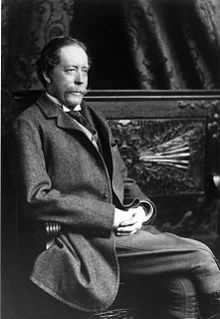 | |
| Born |
September 18, 1836 Leipsic, Delaware, USA |
| Died |
March 13, 1909 (aged 72) Colorado Springs, Colorado |
| Place of burial | Evergreen Cemetery in Colorado Springs |
| Allegiance |
Union |
| Service/branch |
Union Army |
| Years of service | 1861 - 1865 |
| Rank |
|
| Unit |
|
| Commands held |
|
| Battles/wars | American Civil War |
| Awards | Medal of Honor |
| Other work | Founder of Colorado Springs, Colorado and builder of the Denver and Rio Grande Western Railroad |
William Jackson Palmer (September 18, 1836 – March 13, 1909) was an American civil engineer, soldier, industrialist, and philanthropist.[1] During the Civil War, he was made General (brevet) and was a Medal of Honor recipient.
Palmer's early career helping build and develop the expanding railroads of the United States in Pennsylvania was interrupted by the American Civil War (1861–65). He served in colorful fashion as a Union Army colonel and was appointed to the brevet grade of brigadier general. After the War, he contributed financially to educational efforts for the freed former slaves of the South.
Heading west in 1867, while Palmer helped build the Kansas Pacific Railway he met a young English doctor, Dr. William Abraham Bell who became his friend and partner in most of his business ventures in which we would generally find Palmer as president with Bell as vice president. The two men are best known as co-founders of the Denver and Rio Grande Western Railroad (Rio Grande). The Rio Grande and its successors eventually operated the largest network of narrow gauge railroad in the United States, and ultimately became part of the 21st century Union Pacific Railroad.
Palmer and Bell are notable for observing in Great Britain (Bell's country of origin) and helping introduce to the United States railroads, the practices of burning coal (rather than wood) and the use of narrow gauge railroading. He helped develop rail-related industries in Colorado, such as a large steel mill near Pueblo. He was the founder of the new city of Colorado Springs, in 1871, as well as several other communities. After moving west, General Palmer continued his philanthropic efforts in his adopted home, particularly educational institutions of higher education. Public schools in Colorado Springs were named for both the General, and his wife, Mary (née Mellen) Palmer, who was known by her nickname of "Queen". A statue of Palmer also exists in downtown Colorado Springs, across from the school named in his honor.
Early life
William Jackson Palmer was born to a Quaker family near Leipsic, Kent County, Delaware on Kinsdale Farm in 1836.[2]:13 His parents were John and Matilda (Jackson) Palmer.[3]:8 When he was five years old, his family moved to Germantown in Philadelphia, Pennsylvania, where he attended Friends School, Zane Street School, and Boys' High School.[2]:13
Pennsylvania railroads
In 1851, Palmer went to work in western Pennsylvania for Hempfield Railroad's engineering department as a clerk. Two years later, at age 17, he worked under chief engineer Charles Ellet, Jr. as a rodman. Palmer became transitman for Hempfield in 1854.[3]:8
Frank H. Jackson, president of Westmoreland Coal Company and Palmer's uncle, encouraged him to go to England to study coal mining and railroads.[2]:33,372 Palmer was particularly interested in running railroad engines on anthracite coal. He left in the summer of 1855 for a six-month period and wrote articles for Miner's Journal of Pottsville, Pennsylvania to finance the trip abroad. He also borrowed money from his uncle.[2]:33,372[lower-alpha 1] While in England, he met with noted railroad engineers—like Isambard Kingdom Brunel and Robert Stephenson—and visited railroads, mills, and coal mines.[2]:372
Palmer went to work in 1856 for Westmoreland Coal Company as secretary and treasurer.[3]:8 The following year he worked at Pennsylvania Railroad and became private secretary to John Edgar Thomson,[3]:8 a successful Quaker businessman.[2]:372 Palmer wrote, Reports of Experiments with Coal Burning Locomotives and learned about running a railroad from Thomson.[2]:372 Palmer began an evaluation of converting engines to run on coal, which was more abundant, rather than wood. His findings were key to changing the type of fuel used to run the country's locomotives.[2]:113–114 He began a relationship with Thomas A. Scott at Pennsylvania Railroad, who was the Secretary of Transportation during the Civil War.[2]:114
Civil War
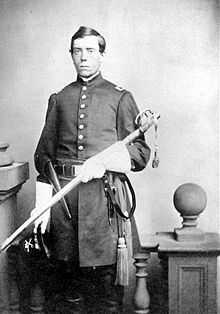
As the American Civil War began in 1861, although his Quaker upbringing made Palmer abhor violence, his passion to see the slaves set free compelled him to enter the war. Palmer took a commission as a colonel in the Union Army.[2]:27–28 Palmer served under General Don Carlos Buell in the Anderson Troop that he organized in the fall of 1861.[3]:8 He was elected the troop's captain.[2]:46–47 Impressed with the "elite scouts" that Palmer had assembled, Buell asked Palmer to recruit an entire regiment from Pennsylvania.[4] In ten days in 1862, Palmer formed the 15th Pennsylvania Cavalry of 1,200 men. He was made the regiment's commanding officer and a colonel.[3]:8[2]:47
In 1862, he was captured by the Confederates while scouting after the Battle of Antietam. He was well within Confederate lines, garbed in civilian clothes, while gathering information for General George McClellan.[4] When questioned, Palmer gave his name as "W.J. Peters," and claimed to be an engineer on an inspection trip. He was interrogated by General William N. Pendleton, who thought he was a spy. He was detained and sent to Richmond, Virginia, with a rambling note from Pendleton that was ignored.[4] Palmer was incarcerated at the notorious Castle Thunder prison on Tobacco Row, Richmond.
Palmer was set free in a prisoner exchange, recuperated two weeks, and rejoined his regiment in February 1863.[4]While he was in Castle Thunder, the number of officers had dwindled significantly due to death or illness. As a result, the regiment had become mutinous and many soldiers faced the likelihood of going before a firing squad for refusing to fight. Palmer reorganized the regiment and withdrew the death charges for soldiers on the condition that they behaved going forward.[4] The severely demoralized group of men rallied and were successful during the 1863 Tullahoma Campaign, the capture of Brig. Gen. Robert Vance's cavalry and transported food supply, and the 1864 Battle of Nashville.[4] Not easily impressed, Major General George H. Thomas recommended that Palmer receive a brigadier's star for his success at turning a highly demoralized group of men to an effective group of soldiers.[4]
Palmer was very vigorous in pursuing Confederate General John Bell Hood after the Battle of Nashville in 1864. On March 9, 1865, President Abraham Lincoln nominated Palmer for appointment to the brevet grade of brigadier general of volunteers and the U.S. Senate confirmed the appointment on March 10, 1865.[5]:754 In April 1865, Palmer commanded troops in pursuit of Jefferson Davis following the surrender by General Joseph E. Johnson. Davis was followed through North Carolina, South Carolina, and Georgia and driven into the hands of General James H. Wilson.[1]:9899[2]:58 Palmer was mustered out of the Union Army volunteer force on June 21, 1865.[5]:415
General George Henry Thomas wrote of Palmer:
There is no officer in the regular or volunteer service who has performed the duties which have devolved upon him with more intelligence, zeal, or energy than General Palmer, whose uniform distinguished success throughout the war places his reputation beyond controversy.[1]:9899
On February 24, 1894, Palmer was awarded the Medal of Honor for his actions as colonel leading the 15th Pennsylvania Cavalry at Red Hill, Alabama, January 14, 1865 where "with less than 200 men, [he] attacked and defeated a superior force of the enemy, captured their fieldpiece and about 100 prisoners without losing a man."[5]:415
Western railroads
Kansas Pacific Railway
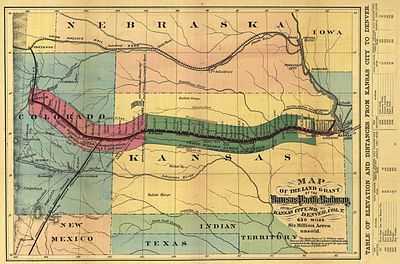
After the War, Palmer resumed the railroad career he had started previous to the conflict. In 1867, a very optimistic, eager 30-year-old Palmer, and his 21-year-old chief assistant Edward Hibberd Johnson, headed west from their hometown of Philadelphia, Pennsylvania.[6] Palmer worked the Kansas Pacific Railway as secretary and treasurer[3]:8 and a managing director responsible for extending service to Denver. The line from Kansas to Denver was completed in 1870.[4][3]:8
Denver and Rio Grande Western Railway
While in the Colorado Territory, Palmer went to Colorado City (now Old Colorado City) to consider a north-south route from Denver for his own railway.[2]:116 Palmer had a vision to build a railroad south from Denver through New Mexico and Arizona to Mexico City.[4] Palmer founded—with Colonel A.C. Dodge, Colonel W.H. Greenwood, Governor Alexander Cameron Hunt, and others—was elected president of the Denver and Rio Grande Western Railroad in 1870.[1]:9900[3]:8 The first section of the railway included the first 3 ft (914 mm) narrow gauge railroad tracks in the West. The line ran south of Denver and across the Palmer Divide, which separates the Platte River and Arkansas River watersheds,[1]:9900 and to Colorado Springs by 1871. The line went to Pueblo in 1872, and further south to coal fields beyond Trinadad in 1873. The railroad had service along the Arkansas River canyon to other coal mining locations, to the metal mining town of Leadville, and the iron mines in Saguache County, Colorado. Palmer stepped down as president in 1883 to focus greater attention on developing the Mexican line.[1]:9900
Rio Grande Western Railway
Palmer was president of the Rio Grande Western Railway from 1881[3]:8 or 1883 to 1901. He built lines from the terminus of the Denver and Rio Grande Western Railway in Grand Junction to the Utah cities of Ogden and Salt Lake City. This provided direct service from Denver to Utah via narrow-gauge railway.[1]:9900
Mexican National Railway
In 1880, Palmer was made president of the Mexican National Railway (now National Railroad of Mexico). Most of the line was completed by 1883.[3]:8 The railroad made it to Mexico City.[7]
Colorado Springs and Manitou Springs
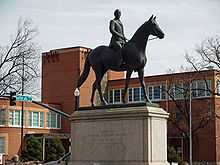
Palmer came to the Colorado Territory as a surveyor with the Kansas Pacific Railway in search of possible railroad routes. Dr. William Abraham Bell from England was also part of the survey party.[9]:viii[2]:110 On July 31, 1871, Palmer and Bell founded Fountain Colony (later Colorado Springs), downstream of Colorado City, and it was laid out by the Colorado Springs Company that year.[9]:viii[3]:8[lower-alpha 2] It was named for three natural mineral springs near Monument Creek[12][lower-alpha 3] or the springs in nearby Manitou Springs.[13]
He also founded the town of Manitou (later Manitou Springs) as a resort town at the base of Pikes Peak.[1]:9900 Palmer spent about $1,000,000 (equivalent to $26,881,724 in 2015) on the construction of roads and development of parks in Manitou Springs, Old Colorado City, Colorado Springs, and Manitou Park.[1]:9901
In Colorado Springs, Palmer provided funding for Colorado College[1]:9901–9902 and within two years, Colorado Springs the town at 1,500 residents, schools, churches, banks, and a newspaper.[4] Palmer donated land to establish the first city park, Acacia, and additional parks: Antlers Park, Monument Valley Park, North Cheyenne Cañon Park, Palmer Park, Pioneer Square Park (South Park), Prospect Lake and Bear Creek Cañon Park. He donated a total of 1,270 acres of land, some of which was also used for scenic drives, tree-lined roadways and foot and bridle paths.[14] Palmer also provided the funding for a school for the deaf, a tuberculosis sanatorium, and libraries.[4] With the land that he also gave for parks, churches, libraries, hospitals, and schools, he donated a total of 1,638 acres. Palmer founded the Colorado Springs Gazette newspaper.[7]
In 1883, he built the Antlers Hotel. When it burned down in 1898, he rebuilt the hotel with Italian Renaissance architecture.[4][lower-alpha 4]
Other towns were founded by Palmer along his railoroad lines, include Salida, Alamosa, and Durango.[7]
Colorado Coal and Iron Company
Palmer envisioned "an integrated industrial complex based on steel manufacturing" in which all necessary resources were controlled by one company.[15] In 1880, Palmer constructed Colorado Coal and Iron Company's (CC&I) steel mill south of Pueblo and laid out the town of Bessemer (now incorporated in Pueblo). The Minnequa plant became one of the greatest iron and steel plants in the country. His dream became a reality for his successors when, in 1892, CC&I merged with the Colorado Fuel Company to form Colorado Fuel and Iron.[15][1]:9900
Personal life
Over the course of his life, Palmer was a member of the Denver Club, Colorado Springs Country Club, El Paso Country Club, City Midday Club (New York), and the Metropolitan Club (New York).[3]:8
Marriage
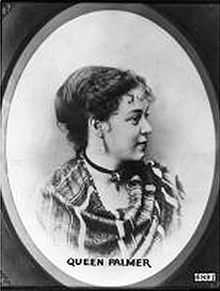
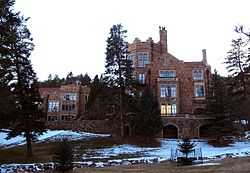
Palmer met Mary Lincoln (Queen) Mellen while she and her father, William Proctor Mellen, were on a train returning from a trip to see the West.[2]:69, 116–117 They were married November 7, 1870 in Flushing, New York where the Mellen family lived at the time. They spent their honeymoon in Europe.[2]:71 They had three daughters, Elsie, Dorothy, and Marjory.[3]
Palmer built his Glen Eyrie, Scottish for "Valley of the Eagle's Nest," in 1871 near Colorado Springs.[1]:9901[2]:215,221 Queen taught at Colorado Springs' first school.[7]
Palmer had apartments in London and New York, a castle near Mexico City, and property throughout Colorado.[2]:75 The Palmers traveled frequently with their children and governesses to New York and London for William's business and lived part-time at Glen Eyrie in Colorado.[2]:75
While pregnant with their middle daughter, Dorothy, Queen suffered a heart attack in Leadville during a vacation. Dorothy was born a few weeks later at Glen Eyrie. Then, their third daughter, Marjorie, was born in England. Two maids and a doctor had accompanied them on the trip.[2]:75 Over the next four years, Queen often lived on the East Coast or England, with visits by Palmer. In 1885, she left Glen Eyrie permanently, needing to live at a lower altitude. About 1887, Queen and the girls lived permanently in England.[2]:75 William and Queen vacationed in France and Italy in the spring of 1889. Queen died in England on December 27, 1894, at the age of 44.[2]:78
Retirement
When Palmer retired from business, he devoted himself to philanthropic endeavors, giving away $4 million (equivalent to $104,992,593 in 2015). In 1906, Palmer suffered a fall from a horse and was paralyzed.[1]:9902 Left with a broken spine, Palmer was thereafter confined to a wheelchair.[4]
Unable to travel, Palmer hosted the veterans of his 15th Pennsylvania Volunteer Regiment troopers for their annual reunion in 1907 at Glen Eyrie. He paid the travel expenses for 208[4] or about 260 veterans.[1]:9902 Mrs. J.A. Hayes, the wife of a prominent Colorado Springs banker and daughter of Jefferson Davis was an honored guest at the reunion.[1]:9902–9903
William Jackson Palmer died on March 13, 1909 at the age of 72.[2]:78 On the day of his death schools, businesses, and trains stopped and flags flew at half mast in Colorado Springs. The mayor said Palmer was "the soldier, the builder of an empire, the philanthropist, the friend of the people, whose life was a blessing." Gazette journalist Dave Phillips said that he was "an ardent pacifist, humanitarian and champion of preserving wildlands at a time when conservation was almost unheard of."[7] His and Queen's ashes are buried at Evergreen Cemetery in Colorado Springs, Colorado.[2]:78
Legacy
- Palmer made significant donations to the Hampton University in Virginia, a university built after the end of the Civil War for African-Americans, and Palmer Hall was named in his honor.[16]
- Palmer was the land-grantor of several institutions in Colorado Springs, including the (International Typographical Union's) Union Printer's Home, the Colorado School for the Deaf and Blind, several churches in central Colorado Springs, and Cragmor Sanatorium, a tuberculosis sanitarium which later was re-founded in 1965 as the University of Colorado Colorado Springs (UCCS). See also: Tuberculosis treatment in Colorado Springs
- He provided land and funding for the creation of Colorado College and was one of its founding trustees.[1]:9901 Palmer Hall, the main social science building on the Colorado College campus, is named for the General.[1]:9902
- Queen Palmer Elementary School in Colorado Springs is named in honor of Palmer's wife, Mary (Queen) Mellen Palmer; General William J. Palmer High School in downtown Colorado Springs and Lewis-Palmer High School in nearby Monument are named for the general himself.
- Palmer Divide, a geographic feature north of Colorado Springs, and the community of Palmer Lake, Colorado, are named after him, as is Palmer Park in Colorado Springs.
Medal of Honor citation

- Colonel William J. Palmer of the 15th Pennsylvania Calvary received the Medal of Honor on February 24, 1894 for his service on Red Hill, Alabama on January 14, 1865: "With less than 200 men, attacked and defeated a superior force of the enemy, capturing their fieldpiece and about 100 prisoners without losing a man."[17][18]
See also
- List of American Civil War Medal of Honor recipients: M–P
- List of American Civil War generals (Union)
Notes
- ↑ There are differing opinions about when Palmer went to Europe. The National Cyclopedia of American Biography states that he studied in England about 1854.[3]:8 Lowry says that Thomson sent him to Europe.[4]
- ↑ In reaction to the saloons, prostitution, and opium dens of Colorado City, Palmer purchased the land for the new town east of the wild town and outlawed the consumption of alcohol within the new town's borders. Alcohol was sold, however, by druggists for "medicinal purposes". In 1933, at then end of the Prohibition, Colorado Springs lifted the ban of the sale and consumption of alcohol.[10][11]
- ↑ The springs that were located in what is now Monument Valley Park, were "sealed over" during a significant flood in 1935.[12]
- ↑ The Antlers, built in 1898, was replaced about 1948 with the current, modern Antlers Hotel.[4]
References
- ↑ 1.0 1.1 1.2 1.3 1.4 1.5 1.6 1.7 1.8 1.9 1.10 1.11 1.12 1.13 1.14 1.15 1.16 "Gen. William J. Palmer, A Builder of The West". The World's Work: A History of Our Time XV: 9898–9903. February 1908. Retrieved July 10, 2009.
- ↑ 2.0 2.1 2.2 2.3 2.4 2.5 2.6 2.7 2.8 2.9 2.10 2.11 2.12 2.13 2.14 2.15 2.16 2.17 2.18 2.19 2.20 2.21 2.22 2.23 2.24 Tim Blevins, Dennis Daily, Chris Nicholl, Calvin P. Otto, Katherine Scott Sturdevant (2009). Legends, Labors & Loves: William Jackson Palmer, 1836-1909. Pikes Peak Library District. ISBN 978-1-56735-262-7.
- ↑ 3.0 3.1 3.2 3.3 3.4 3.5 3.6 3.7 3.8 3.9 3.10 3.11 3.12 3.13 3.14 "William Jackson Palmer". The National Cyclopaedia of American Biography. J.T. White. 1904. p. 8.
- ↑ 4.0 4.1 4.2 4.3 4.4 4.5 4.6 4.7 4.8 4.9 4.10 4.11 4.12 4.13 4.14 4.15 Thomas P. Lowry (August 2, 2007). "William J. Palmer: Forgotten Union General of America's Civil War". Civil War Times. Retrieved February 8, 2014 – via Weider History Network.
- ↑ 5.0 5.1 5.2 John H. Eicher and David J. Eicher (2001). Civil War High Commands. Stanford University Press. ISBN 0-8047-3641-3.
- ↑ Dave Phillips (January 2, 2014). "Ask Gen. Palmer: Assistant helped light up the world". The Gazette (Colorado Springs, Colorado). Retrieved February 9, 2015.
- ↑ 7.0 7.1 7.2 7.3 7.4 Dave Philipps (March 8, 2009). "Palmer A Founder, A Father Figure". The Gazette (Colorado Springs, Colorado) – via HighBeam Research. (subscription required (help)).
- ↑ "General William Jackson Palmer Equestrian Statue" (PDF). Colorado Cultural Resource Survey. City of Colorado Springs. March 2004. p. 2. Retrieved February 9, 2015.
- ↑ 9.0 9.1 Deborah Harrison; Manitou Springs Heritage Center (2012). Manitou Springs. Arcadia Publishing. p. 9. ISBN 978-0-7385-9596-2.
- ↑ Jan MacKell (2007). Brothels, Bordellos, and Bad Girls: Prostitution in Colorado, 1860-1930. UNM Press. p. 72. ISBN 978-0-8263-3343-8.
- ↑ Inner Source Designs; Kathy and Lee Hayward (1 November 2009). Drinking and Driving in Colorado: A Guide to Colorado's Brewpubs. Inner Source Designs. p. 112. ISBN 978-0-9822571-1-1.
- ↑ 12.0 12.1 Brandon Fibbs (July 25, 2003). "Fun with the Founder - Move over, Columbus: Colorado Springs founder gets back his holiday". The Gazette (accessed via HighBeam Research) (Colorado Springs, CO).
- ↑ Appleton's Illustrated Hand-book of American Winter Resorts for Tourists and Invalids. D. Appleton. 1877. pp. 75–76. Retrieved May 23, 2013.
- ↑ "Parks, Trails and Open Spaces". City of Colorado Springs. Retrieved May 23, 2013.
- ↑ 15.0 15.1 James Whiteside (1990). Regulating Danger: The Struggle for Mine Safety in the Rocky Mountain Coal Industry. University of Nebraska Press. p. 7. ISBN 0-8032-4752-4.
- ↑ F. Erik Brooks; Glenn L. Starks (September 30, 2011). Historically Black Colleges and Universities: An Encyclopedia. ABC-CLIO. p. 47. ISBN 978-0-313-39415-7.
- ↑ "Palmer, William J., Civil War Medal of Honor recipient". American Civil War website. 2007-11-08. Retrieved November 8, 2007.
- ↑ "Civil War Medal of Honor recipients (M-Z)". Medal of Honor citations. United States Army Center of Military History. August 3, 2009. Retrieved July 1, 2010.
Further reading
- John Stirling Fischer (1939). A Builder of the West: The Life of William Jackson Palmer. Caldwell, Idaho: Caxton Printers.
External links
![]() Media related to William Jackson Palmer at Wikimedia Commons
Media related to William Jackson Palmer at Wikimedia Commons
|